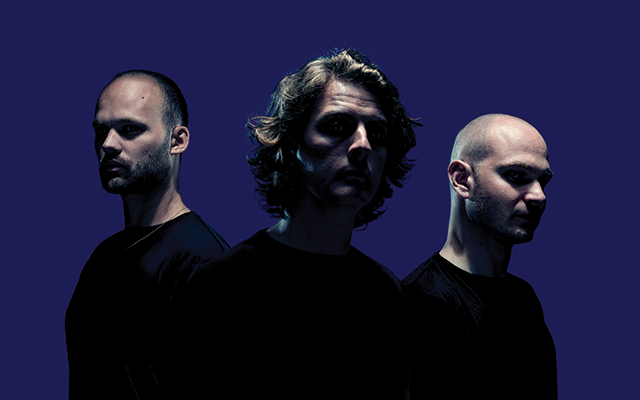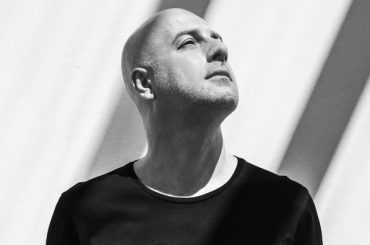Noisia runs a tight ship. The Netherlands-based trio best known for its drum-n-bass productions—although not exclusively so—has impressive headquarters in its hometown of Groningen.
The Noisia DJ ambassadors, Thijs de Vlieger and Martijn van Sonderen, travel often, while Nik Roos stays at De Noisia Kantoor mark III, the aforementioned headquarters that houses their studios, management team, and labels: Vision, Division, and Invisible. This is also where their weekly Noisia Radio program is recorded, showcasing material that doesn’t quite fit into their sets. And some of the ideas for their international Noisia Invites events, where they host a range of artists, depending on the location, are hatched here.
Noisia churns out a steady stream of releases, from themselves, with a wide cross-section of collaborators, and from artists with whom they have a musical connection. A full album of Noisia material, however, does not happen very often. Six years since the trio’s last full-length, Split The Atom, it returns with Outer Edges, an 18-track multi-genre behemoth. (Editor’s Note: At presstime, it was reported that the album had been leaked online and its release moved up six weeks.)
“An album is a chance to make a broad statement,” says Roos. “Outer Edges is similar to Split The Atom in the sense that we explored different genres and chose from a palette that is descriptive of us as artists. We didn’t try to make current-sounding tracks. It’s a blueprint for the period that follows. This is much more diverse, a listening album with each track being its own thing.”
The noticeably collaborator-free Outer Edges had a number of its tracks available online prior to its release. From highly stimulating tunes such as the intense “Vigilantes” and “Voodoos,” to the Ed Rush and Optical-inspired funky swings of “Tentacles” and “Straight Hook,” to the sharp compositions of “Mantra,” “Motion Blur,” and “Into Dust” to the half-time/beats cuts that make up a significant portion of the album, there’s plenty to take in.
The process for Outer Edges started with demo-listening sessions from each member. Then, as a group, they decided which ones they felt most excited about finishing together. Their three studios, which are networked, run Cubase with plug-ins from Fab Filter, iZotope, Native Instruments, and Melda.
Roos, whose specialty is drums, bass, and mixdowns, has some analog synths: Moog Sub 37, Korg SV-1, Roland FA-06. As the arrangements expert, van Sonderen uses a Roland HP 505 digital piano. And de Vlieger, who has gone over the top with the modular equipment and outboard pieces, has become the creator of strange sounds, chord sequences, and fringe elements.
“I have three different approaches to drums,” says Roos. “One is making everything with synths: Serum and Native Instruments FM8. That can go from really synthetic-sounding to trying to make stuff that doesn’t sound synthetic. ‘Get Deaded,’ the snare is five instances of Serum, the kick is four instances of Serum and seven instances of rides and hats and cymbals.
“On the second drop, we threw in sounds I made in Superior Drummer, which are recorded drum kits. That’s the second way, using Superior Drummer VST, where you put together a drum kit of different parts, tune them individually and send the mikes to different outputs then mix like you’re in a big recording studio, that way you can make your own breakbeats and sample them. The third way is to use an old sampled funk break, cut it apart, split it to multiple channels, and see how you can make it sound better or change the programming.”
As one of the few drum-n-bass acts which plays headlining timeslots at festivals, Noisia’s latest material comes with a new audio/visual presentation which includes all three members. This is designed by Roos, who is very clear that this is not a live show.
“The music we make,” he says, “it doesn’t make sense to have the VSTs in real-time if there’s not that much you’re going to change or play live. We tried to design as much of the experience with the lights and visuals being very deliberate and triggered live by the MIDI signals. When [van Sonderen] starts mixing a song, he sends MIDI and OSC to me and our lighting tech. All the faders are also being sent to visuals and I can control the layers and effects from my station on stage. [De Vlieger] isolates certain elements of the songs running them through his modular set-up.
“I’ve got an Ableton Live project with all the MIDI from the songs that are in the show,” he continues, explaining the development process in the studio. “I’m going track by track and deciding what MIDI is going to trigger which layer of the visuals. To give me an idea of the combination, I have made visualizations of the lights made by our lighting tech, also based on the same MIDI. I can see which notes he’s targeting, and what the lights are doing on his cue. If he’s taking the snare, I’ll take the kick, or he does one section and I’ll black out or illuminate another one. During the show, it’s all cued live.”








